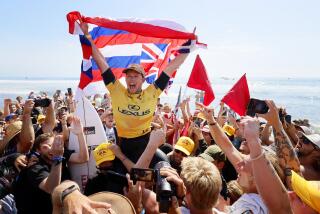Tour Leader Rides Wave of Popularity
- Share via
When Sofia Mulanovich returned home to Peru in late December, having fulfilled a dream that had been her obsession for 10 years, she discovered that dreams can develop a life of their own.
At the airport were hundreds of admirers, cheering her arrival, waving banners and flying balloons. Reporters wanted her story, and photographers, cameras flashing, wanted to capture the moment, such as it was, with the humble young surfer looking more astonished than anything else.
She was, after all, a surfer. Not a soccer player. And it was after midnight.
“I was so overwhelmed that I really don’t remember much about it,” Mulanovich says, adding that her life has been a blur ever since. “I had no idea how much people cared about my achievements.”
In only her second season on pro surfing’s elite tour, she realized her dream by winning the world championship, ending the six-year reign of Australia’s Layne Beachley. It stamped Mulanovich as the first of a new generation of powerful and technically sound young surfers to wear the crown.
But the significance went beyond that. She became the first Latin American surfer to win a world title since the Assn. of Surfing Professionals was founded and brought legitimacy to the sport in 1976. Moreover, she gave her proud homeland something soccer players have not been able to deliver: a winner on a world stage.
“Sofia Mulanovich has become a social phenomenon in Peru,” says Hans Firbas, her suddenly overworked press agent. “To have obtained a worldwide championship for Peru has been important, so that she is at the moment a superstar.
“Sofia’s popularity is due not only to her success as a world champion, but to her simplicity, naturalness and modesty that she always carries with her. She is one of us, and the people admire her for it.”
Mulanovich, 21, is uncomfortable in the spotlight but she has been unable to escape it. News conferences and talk show appearances have consumed her calendar. President Alejandro Toledo presented her with the Laurels Sport Award, a recognition reserved for top athletes. She was recently voted Peru’s most popular person.
Though short on physical stature, she stands 5 feet 3, Mulanovich has become larger than life. Gigantic billboards bearing her likeness have sprouted along thoroughfares leading from Lima to the coast.
Because of her success, Peruvians have become reacquainted with their rich surfing heritage, which had faded from memory in recent decades as the nation struggled through tumultuous, often perilous times.
“You can tell by looking at the TV, listening to the radio or reading the newspapers: All the media has something to say about Sofia, and this all helps the popularity of the sport,” says Jose Schiaffino, a Peru-based sales representative for surfwear giant Quiksilver, and its girls’ division, Roxy.
“Just to give you an idea, one of the best surfing schools in Lima now has a proportion of students of 70% girls and 30% boys, and Roxy sales this year increased in some divisions by as much as 50%.”
At a recent ASP World Qualifying Series tour event, staged in Mulanovich’s honor near her home, 20,000 people showed up to applaud their national hero, who bowed out in the semifinals of a contest that, for her, was largely ceremonial.
Mulanovich says she’s touched to have had so great an effect, but at the same time she’s relieved to have finally gone back on the road for another run at the title -- the 2005 season begins Tuesday on Australia’s Gold Coast -- because it’ll restore some order in her life.
“It has been pretty crazy,” she says.
*
Crazy times were a part of Peru’s recent past, with anti-government bombings, kidnappings and assassinations occurring regularly in and around the cities. The Mulanovich family lived in relative seclusion in Punta Hermosa, a coastal village about 30 miles west of Lima, but they were prisoners of the realities that surrounded them.
“We were really frightened to go anywhere, to the bank, to the malls, the movies and restaurants,” recalls Ines Mulanovich, Sofia’s mother. “People were killed every day.”
Sofia and her brothers attended a private school in Lima and were transported with other students in bulletproof vehicles. “Sofia was very young at that time, and fortunately it was not very shocking for her as it was for us adults,” Ines adds.
Herbert Mulanovich worked for a fish factory as an exporter; Ines was in the restaurant business. Beautiful blue waves, visible from their house, beckoned on most afternoons. Their children learned to surf early. Herbert Jr., now 25, became a national champion. Matias, 18, plans to follow in Sofia’s wake and use the WQS as a springboard to the World Championship Tour.
Sofia began surfing at 10, and almost from day one she dreamed of becoming a world champion. She idolized Lisa Andersen at a time when Andersen was realizing her dream. Having moved from Florida to Southern California to immerse herself in the sport and culture, Andersen won four consecutive world championships in the mid-1990s and elevated women’s surfing to new heights.
Mulanovich, surfing against mostly boys in local competitions, stood out with her fluid and aggressive style. Billabong signed her to a small-scale sponsorship deal before Roxy, with Andersen as its poster child, stole her away by offering a full salary.
Mulanovich started competing on the WQS full time in 2001. It was a humbling experience, and she failed to earn enough points to advance to the top-level WCT. But in 2002 she finished second on the WQS and moved up.
She made friends immediately because of a mellow demeanor that has not diminished, her friends say. “Sofia is always looking for ways not to stand out,” says Megan Abubo, a WCT veteran from Hawaii. “If she wins a contest, she just wants to be part of the gang and hang with her friends. She is so cool. She never makes you feel bad if she wins and you lose, and she never says anything bad about anyone.”
Mulanovich finished seventh out of 17 WCT surfers in 2003, but last year she came out determined to just have fun. “I think I surfed better because I was not worrying so much about everything,” she says. “Before I always felt the pressure and thought I had to perform for everybody else.”
She took a commanding points lead early in the season after winning three consecutive events, in Fiji, Tahiti and France. She clinched the title in the second-to-last event, the Roxy Pro Haleiwa in mid-December on Oahu’s North Shore.
It was a defining moment as she had struggled with her emotions beforehand, because while a high finish would secure the title, it would also knock her close friend and closest pursuer, Rochelle Ballard, out of contention.
“She was sad and said she just wanted to be alone and I could sense that something was wrong,” recalls her career manager, Susan Izzo. “I had to take her aside and remind her of who she is and what she was doing and why. She wanted [the title]. No doubt about that. But she had to learn to separate competition from friendship.”
Ballard, 34, a North Shore resident and tour veteran who has never won a world title, held a party for Mulanovich and invited many of her friends to help celebrate her triumph.
Soon afterward it was time for Mulanovich to go home, where the real party was just getting started.
More to Read
Go beyond the scoreboard
Get the latest on L.A.'s teams in the daily Sports Report newsletter.
You may occasionally receive promotional content from the Los Angeles Times.










